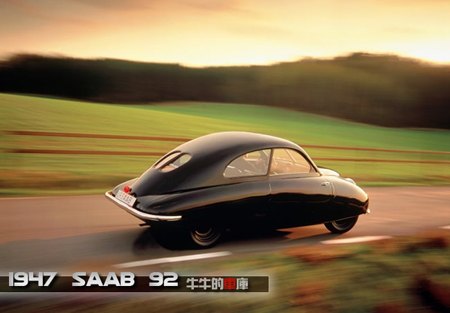GM Tog Saabs USA-vinst (Union Says GM Cooked Saab's Books)
Dagens Industri has published a letter from Saab’s union bosses which accuses GM of playing silly buggers with the brand’s accounts. As Saabs United says, “The report tends to support the idea that GM are handy at shuffling results around to suit their reporting needs.” [Thanks for the TTAC translation to commentator Naser Rouholamin]
Recently, the future of SAAB has been the subject of many allegations and much debate. Specifically we are thinking about such claims as “using tax money for playing monopoly”, or “SAAB has always made a loss, hence there is no point in saving it now”.
In order to rebuke the latter claim one must realise that not even GM would have kept Saab afloat the last 20 years from pure goodwill.
Unfortunately, for a variety of reasons GM has chosen to place losses on Saab.
But it’s the result on the last row in the corporation’s balance sheet that is of interest. As an example of how this can be done we can look at the 2007 fiscal year, when Saab sold 120000 cars, of which 85000 were in Europe.
The cars sold in Europe generated profits for Saab whilst the rest, predominantly US market cars, did not generate profits. However that is not strange considering that sales revenue for these cars was taken by GM in the USA, meaning that Saab bore the costs but saw no sales revenue in return.
The above example shows how the accounts in a global company are treated. It can be very misleading for those who do not know the background information. Thus the allegations that Saab has never made a profit are not correct.
Regrettably the debate on how taxpayer’s money should be spent and invested is more centred on political rhetoric than reliable industrial policy.
Saab has requested that the government guarantee loans from the European investment bank, not that the government should become an owner or give Saab a grant with taxpayer money. Acting as a guarantor on the loan, together with GM, is a prerequisite for in Saabs business plan. This plan means bringing production and development of new products back to Sweden. Furthermore securing the loan will make Saab more attractive to new owners.
The risk involved with guaranteeing this loan is seems quit reasonable when compared the consequences of Saab failing with its restructuring and at least 15000-20000 people in and around Saab loosing their jobs, people who are also tax payers.
This loss tax revenue and the money which the government would have to spend if Saab, and as a result many of its suppliers, go bankrupt would far exceed the 5 billion Swedish kronor which the government would be guaranteeing. And in the case of a bankruptcy the taxpayers will defiantly have to foot the bill.
More by Robert Farago
Latest Car Reviews
Read moreLatest Product Reviews
Read moreRecent Comments
- Kjhkjlhkjhkljh kljhjkhjklhkjh A prelude is a bad idea. There is already Acura with all the weird sport trims. This will not make back it's R&D money.
- Analoggrotto I don't see a red car here, how blazing stupid are you people?
- Redapple2 Love the wheels
- Redapple2 Good luck to them. They used to make great cars. 510. 240Z, Sentra SE-R. Maxima. Frontier.
- Joe65688619 Under Ghosn they went through the same short-term bottom-line thinking that GM did in the 80s/90s, and they have not recovered say, to their heyday in the 50s and 60s in terms of market share and innovation. Poor design decisions (a CVT in their front-wheel drive "4-Door Sports Car", model overlap in a poorly performing segment (they never needed the Altima AND the Maxima...what they needed was one vehicle with different drivetrain, including hybrid, to compete with the Accord/Camry, and decontenting their vehicles: My 2012 QX56 (I know, not a Nissan, but the same holds for the Armada) had power rear windows in the cargo area that could vent, a glass hatch on the back door that could be opened separate from the whole liftgate (in such a tall vehicle, kinda essential if you have it in a garage and want to load the trunk without having to open the garage door to make room for the lift gate), a nice driver's side folding armrest, and a few other quality-of-life details absent from my 2018 QX80. In a competitive market this attention to detai is can be the differentiator that sell cars. Now they are caught in the middle of the market, competing more with Hyundai and Kia and selling discounted vehicles near the same price points, but losing money on them. They invested also invested a lot in niche platforms. The Leaf was one of the first full EVs, but never really evolved. They misjudged the market - luxury EVs are selling, small budget models not so much. Variable compression engines offering little in terms of real-world power or tech, let a lot of complexity that is leading to higher failure rates. Aside from the Z and GT-R (low volume models), not much forced induction (whether your a fan or not, look at what Honda did with the CR-V and Acura RDX - same chassis, slap a turbo on it, make it nicer inside, and now you can sell it as a semi-premium brand with higher markup). That said, I do believe they retain the technical and engineering capability to do far better. About time management realized they need to make smarter investments and understand their markets better.


































Comments
Join the conversation
Agreed. A little work and the 92 would sell like hotcakes.
The car in picture was the prototype. Link. The production 92 was dumpier. Link. I think the prototype would be a great place to start from for a modern reinterpretation. I don't think you would use a 3 cyl. 2 stroke engine cooled by thermo-siphon, though.